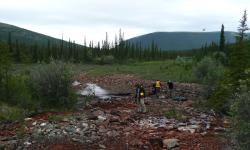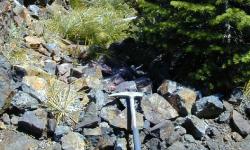Eagle Plains Signs Letter of Intent with Viceroy on B.C. Gold-Copper Porphyry Project
British Columbia | February 24, 2003Cranbrook, B.C.: Eagle Plains Resources Ltd. (EPL:TSX-V) and Viceroy Resource Corporation (VOY: TSE) have signed a Letter of Intent whereby VOY may earn an interest in the Kopper King and KK mineral claims held 100% under option by Eagle Plains. The claims consist of 71 units (4300 acres) located approximately 65km southwest of Telegraph Creek in north-western British Columbia, and overlie the Copper Canyon alkalic porphyry gold-copper deposit.
Subject to regulatory approval, VOY could earn a 51% interest in the property by making a total of $270,000 in cash payments (with $20,000 paid on signing), issuing shares worth $200,000 and completing $1,000,000 in exploration expenditures over 5 years. In addition, VOY would complete a private placement financing in Eagle Plains for 600,000 non flow-through common shares at $0.25 per share ($150,000) with a two-year warrant at $0.30 for the first year, and $.35 for the second year (see news release February 12, 2003).
Upon election by EPL, VOY may increase its stake in the project to 60% by completing a total of $2,500,000 in expenditures. Upon VOY earning 60%, EPL may elect to participate or to be carried to a bankable feasibility stage. If EPL elects to be carried, VOY will earn 75% of the project by delivering a bankable feasibility study. At this stage EPL may elect to be carried for a 20% working interest to commercial production, with the cost share being recovered by VOY from 80% of EPL’s cash flow.
Previous work at Copper Canyon indicates the presence of widespread values in copper, but with significant gold metal values. Mineralization occurs in three distinct areas within the property; namely the Central (formerly Western), North, and Eastern Zones. The largest of these is the Central Zone, where the majority of exploration activity to date has occurred. Drilling highlights include: 90-DDH-1: 22.0 meters grading 4.11 grams/tonne (g/t) Au, 13.02 g/t Ag and 0.71% Cu; 90-DDH-2: 117.0 meters of 2.47 g/t Au, 38.39 g/t Ag and 1.84% Cu; 90-DDH-4: 13.0 meters of 4.04 g/t Au, 33.25 g/t Ag and 1.54% Cu; 90-DDH-5: 32.0 meters of 2.37 g/t Au, 17.48 g/t Ag and 0.77 % Cu. These intersections are within wide lower-grade envelopes such as found in 90-DDH-2 where a 270.8m (898’) intersection averaged 1.92 g/t Au, 22.28 g/t Ag and 1.05% Cu (G. Leary, M.Sc., P.Eng. Assessment Report #21062). At the end of 1990 drilling, an inferred resource for a portion of the Central Zone was published as 35.7 million tons grading 1.17 g/t gold, 0.75% copper, and 17.1 g/t silver (Canamax Resources/ Consolidated Rhodes Resources news release; May 27, 1991). It was further stated that “the Central, North, and Eastern copper zones were also estimated to have the potential to host an additional 100 million tons of reserves”. (Though these estimates are considered by Eagle Plains to be relevant, their reliability has not been confirmed, but will constitute a target basis for future exploration work).
Geology consists of a suite of Upper Triassic-Middle Jurassic alkalic intrusives emplaced into a coeval volcanic pile. Mineralization is hosted within both intrusive and volcanics, and is commonly found associated with k-spar flooding and biotization. Gold has likely been introduced in two stages, one with the main period of alteration and copper mineralization and the other associated with later footwall pyrite. Oxidation products including malachite, azurite, chrysocolla and black manganese stain occur widespread as fracture coatings throughout the mineralized zones.
The property history dates back to August, 1956 when American Metal Co. Ltd (which through corporate restructuring became Canamax Resources) staked the original claims overlying prominent copper gossans in the area. Seven narrow-diameter holes totaling 1009m were drilled in 1957. Though poor core recoveries were encountered, the widespread nature and grade of mineralization was confirmed. Two separate geophysical programs were completed on the property during the early 1960s, with the property remaining dormant until 1988, when Canamax re-examined the area for its gold potential. In 1989, Consolidated Rhodes Resources Ltd. purchased an option to earn a 50% interest in the claims from Canamax. Drilling commenced in 1990, when Consolidated Rhodes completed 15 widely-spaced holes totaling 3,785m over the three known mineralized zones (four of which twinned 1957 holes). Consolidated Rhodes carried out further surface work in 1991 and announced continuing drilling activity in 1992, though no such work was completed, apparently due to unfavorable market conditions prevalent at the time. Canamax merged to create Canada Tungsten in 1993, and the property again became dormant. The claims forfeited in August, 2001, and were immediately acquired by staking - the first time this opportunity had arisen since 1956.
Management of Eagle Plains feels that the agreement with Viceroy is consistent with the company’s corporate strategy of advancing projects of merit which may be reassessed under evolving economic parameters; whether corporate, political, technological, infrastructure-related, or otherwise. The Copper Canyon property is considered to be a project that may benefit from increasing gold prices, technological advances, and a favorable political climate currently present in British Columbia.
To view a location map and recent geological report in pdf format please go to our Copper Canyon project page.
On behalf of the Board of Directors
Signed
“Tim J. Termuende”
President and CEO
For further information on EPL, please contact Mike Labach at 1 866 HUNT ORE (486 8673)
Email: mgl@eagleplains.com or visit our website at http://www.eagleplains.com
Cautionary Note Regarding Forward-Looking Statements
Neither the TSX Venture Exchange nor its Regulation Services Provider (as that term is defined in the policies of the TSX Venture Exchange) accepts responsibility for the adequacy or accuracy of this release. This news release may contain forward-looking statements including but not limited to comments regarding the timing and content of upcoming work programs, geological interpretations, receipt of property titles, potential mineral recovery processes, etc. Forward-looking statements address future events and conditions and therefore, involve inherent risks and uncertainties. Actual results may differ materially from those currently anticipated in such statements.
Latest News Releases
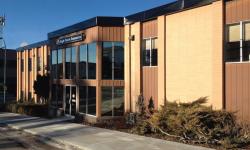
Eagle Plains Shareholders Approve all Matters at Annual General Meeting
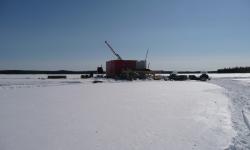
Eagle Plains’ Partner Refined Energy Corp. Approves 2026 Drill Program for the Dufferin West Project, Saskatchewan
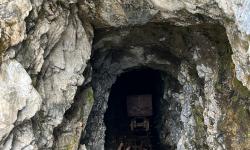
Eagle Plains Reports up to 29.9 g/t Au over 1.8m at the Bulldog Gold – Silver Project, Golden Triangle, BC

Eagle Plains Partner Xcite Resources Commences Airborne Geophysical Surveys at Uranium City Area Projects, Saskatchewan
